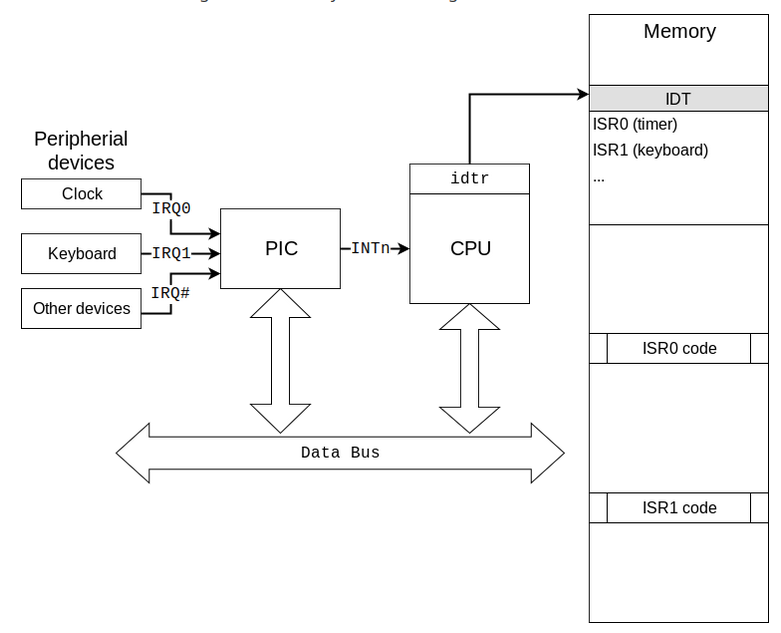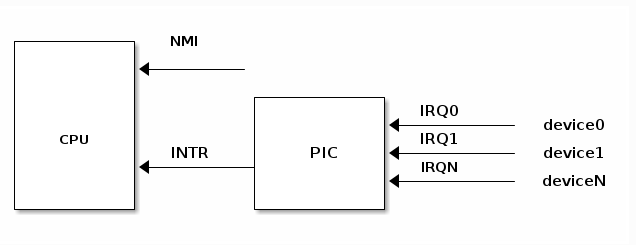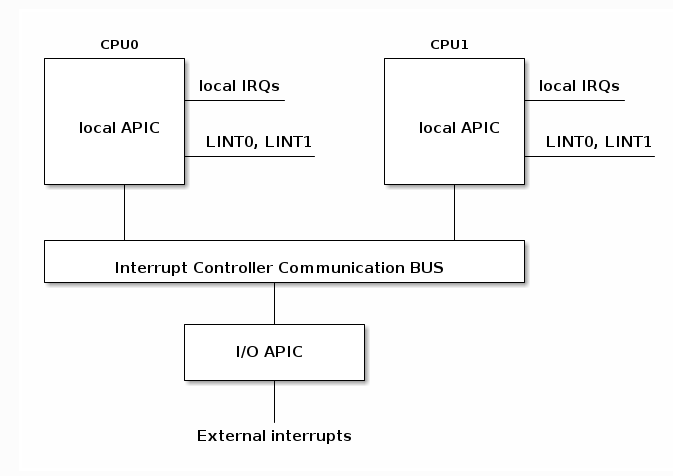tags : Operating Systems, Linux
Interrupt What?
- Interrupt might sound like something bad/annoying
- When you type, your keyboard is sending interrupts to the cpu; It’s something that needs immediate attention.
cat /proc/interrupts
irqtopHow an interrupt happens

- Device raises an interrupt on the corresponding IRQ pin
PICraises an interrupt on CPUINTRpin- PIC waits for CPU to acknowledge before issuing new stuff
- If the interrupt is accept by the CPU
- The processor suspends its current activities
- Saves its state
- Looks up an
ISRentry for that specific interrupt from Interrupt Descriptor Table (IDT) - Executes a function called an
ISR/ interrupt handler.
Interrupt controller
IRQs need a Interrupt controller, maintains the index of IRQs.
Interrupt handler/ Interrupt service routine/ ISR
- Interrupt handlers are expected to set interrupt flags
- This is provided by OS
- In Linux this is done in 3 phases: critical, immediate and deferred.

Interrupt Context
- Interrupt Context =
ISRreturn time -ISRstart time (That time window) - Code is said to be running in Interrupt Context.
- NO WAY TO DO CONTEXT SWITCH (no sleep, user memory access etc)
- To keep the interrupt context short, it allows to have defered actions.
-
Tasklets (Defer Action)
- Runs in interrupt context
- Dynamically allocated
- For most purposes, tasklets are much easier to write cuz no need to be reentrant.
-
Soft IRQs (Defer Action)
- Runs in interrupt context
- Statically allocated
- Run concurrently on several CPUs, even if they are of the same type.
- Reentrant functions, and must protect stuff with
spin locks.
$ irqtop -S HI high priority tasklet softirq SCHED schedule softirq TIMER timer softirq RCU RCU softirq NET_RX network receive softirq BLOCK block device softirq TASKLET normal priority tasklet softirq HRTIMER high resolution timer softirq NET_TX network transmit softirq IRQ_POLL IO poll softirq
-
Workqueues (Defer Action)
- Deferred work that runs in
process context - Implemented on top of kernel threads.
- Deferred work that runs in
Interrupt Descriptor Table (IDT)
- Used as a jump table by the CPU when a given vector is triggered
- May reside anywhere in physical memory
- It stores pointers to
ISRthat will be automatically invoked by CPU on interrupt receive.
Interrupt request/ IRQ
Processors can enable/disable IRQs by setting interrupt masks. Certain IRQs that cannot be disabled.
Hardware interrupts (async / external execution/ HW to CPU)
- hw interrupt request is an electronic signal from hw device external to the processor
- Communicate that the device needs attention from the operating system (OS).
- Each device is associated with a particular IRQ signal.
Exception interrupts (sync / internal execution/ CPU to Kernel)
Generated internally by the CPU and used to alert the running kernel of an event or situation which requires its attention.
Faults (Recoverable)
- This is reported before the execution of the instruction
- So can be usually corrected.
- Eg. Page Fault
Traps (Recoverable)
- Reported after the instruction executed in which exception was detected
- Eg. debug trap, integer overflow
Aborts (Non Recoverable)
- Imprecise exceptions.
- Double fault, second fault while handling first
- Typically do not allow reliable program restart.

